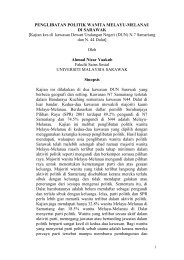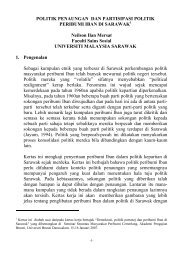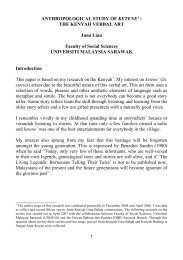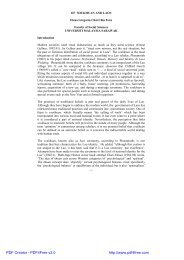RUBBER AND THE MODERNISATION OF THE PAKU IBAN IN ...
RUBBER AND THE MODERNISATION OF THE PAKU IBAN IN ...
RUBBER AND THE MODERNISATION OF THE PAKU IBAN IN ...
You also want an ePaper? Increase the reach of your titles
YUMPU automatically turns print PDFs into web optimized ePapers that Google loves.
was given a concession to plant rubber in Lundu Hill 9 , as the soil there was<br />
more suitable (The SG, Vol L, 1920, No. 802: 217) 10 . In the same year, a<br />
rubber plantation was established in Paok, Bau 11 .<br />
Rubber “is a vital British product” to be exported to the United States, which<br />
needed 100,000 tons of rubber a year (The SG, Vol. XLVI, No. 702: 1916:<br />
158). In Sarawak, the government encouraged the establishment of large-scale<br />
rubber plantation. By the 1920s, there were few rubber estates in Sarawak<br />
such as: (a) the Sarawak Rubber Estates Limited, which had 2,526 acres of<br />
mature rubber trees on a capital of £120,000, and produced about 1 million<br />
lbs of rubber in 1924; (b) the Dahan Rubber Estates, which started operation in<br />
1924 with capital of £50,000 and 1159 acres; (c) the Lawas (Sarawak) Rubber<br />
Estates, which had 1,023 acres with capital of £40,000, and up to May, 1923 it<br />
had harvested 22,700 lbs of rubber, and (d) the Sungai Tengah Estate (see The<br />
SG, 1923, Vol. LIII, No. 839 & The SG, 1925, Vol. LV, No. 861). Estate<br />
rubber tappers in Sarawak were mainly Javanese who had been imported from<br />
Java.<br />
In Sarawak, individuals who wanted to grow any crop could apply for land<br />
from the Agriculture Department Office. The popularity of rubber could be<br />
seen from the number of applications for land to grow the crop. In May, 1916,<br />
for example, 267 applications were entered at the Agriculture Department<br />
Office, and of this figure, 247 were for the permission to plant rubber, 6 for<br />
pepper, 1 for gambier, and 13 for coconut. The total number of application for<br />
land from January to May 1916 was 2,014, and most of this was for the<br />
permission to grow rubber (The SG, 1916, Vol. XLVI, No. 699: 125).<br />
The vast majority of the rubber gardens in Sarawak are owned by small<br />
holders. In 1955, for example, 250,000 acres of rubber in Sarawak belonged to<br />
small holders. To help the development of rubber small holding, the<br />
government set up a „Rubber Fund Scholarship‟ to train Sarawakians to<br />
become Small Holders‟ Advisors. “Qualified boys of good character” were<br />
sent to the Agriculture School in Malaya for two-year course and followed by<br />
a short intensive refresher course at the Rubber Research Institute there.<br />
9<br />
Lundu town is about 80 kilometers from Kuching.<br />
10<br />
The SG means the Sarawak Gazette.<br />
11<br />
Bau is about 30 kilometers from Kuching.<br />
4







